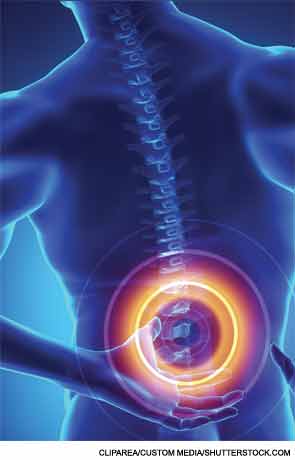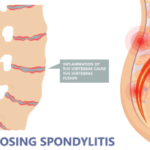
SNOWMASS,CO—Spondyloarthritis (SpA) is a group of several related but phenotypically distinct disorders: psoriatic arthritis (PsA), arthritis related to inflammatory bowel disease, reactive arthritis, a subgroup of juvenile idiopathic arthritis and ankylosing spondylitis (AS). Early treatment of SpA is key, according to Christopher T. Ritchlin, MD, MPH, professor of medicine and director, Translational Immunology Research Center, University of Rochester (N.Y.) Medical Center.
During his presentation, Shifting Sands: Bone Formation and Degradation in Spondyloarthritis at the ACR’s Winter Rheumatology Symposium, Dr. Ritchlin noted that treatment during the early stages of osteitis may stop molecular switching to the bone-forming phenotype that is characteristic of SpA. Treatments that he discussed for their promise in preventing disease progression include tumor necrosis factor inhibitors (TNFi), nonsteroidal anti-inflammatory drugs (NSAIDs) and ustekinumab.
Bone Remodeling
Normal bone remodeling includes a four-part cycle. During resorption, osteoclasts remove bone mineral and matrix to create an erosion cavity. During reversal, mononuclear cells prepare bone surface for new osteoblasts to begin building bone. During formation, osteoblasts synthesize a matrix to replace resorbed bone with new bone. And finally, the resting phase is a prolonged period that occurs until a new remodeling cycle begins.
“Three different groups of molecules direct mesenchymal cells to differentiate into osteoblasts,” Dr. Ritchlin explained. “The first is the BMP [bone morphogenetic proteins] pathway, which triggers the SMAD signaling pathway.” BMPs are cytokines that are involved in the formation of bone and cartilage.
The second group of molecules is the Wnt signaling pathway. “Wnts are secreted glycoproteins that bind to the LRP56, which then couples with the G protein-like Fr Receptor and phosphorylates b catenin that then crosses into the nucleus to initiate transcription of genes involved in osteoblast differentiation,” Dr. Ritchlin said. “Inhibitors of this pathway include the sol Frz R protein, DKK-1 and sclerostin. Interestingly, DKK-1 and sclerostin levels are low in AS, and DKK-2 receptor signaling is defective in AS, which may help explain the anabolic nature of the disease.”
The third pathway is PGE2, which is an important pathway for promoting osteoblast differentiation. “In fact, NSAIDs can inhibit fracture healing and limit heterotopic bone healing, although their therapeutic role in AS is a matter of debate,” Dr. Ritchlin said. “It is important to point out the inter-relationships between these pathways: BMP-2 can induce Wnt-2 expression, and PGE2 can act synergistically with Wnt ligands to increase bone formation.”

The SpA Bone Phenotype
Structural changes in AS are primarily anabolic, Dr. Ritchlin said. “Bony spur formation begins from the cortical bone surface and arises from bony apposition, which has a vertical orientation,” he explained. “Bony spur formation and ankylosis are central features of AS, and evidence suggests that both bony inflammation or osteitis and biomechanical stress are responsible for this phenotype.”
There are several potential driving mechanisms to explain altered bone remodeling in SpA, Dr. Ritchlin said. Two possibilities are a cytokine environment and enthesitis.
Several cytokines and cytokine pathways are of interest in SpA, psoriasis and PsA, Dr. Ritchlin said. These include TNF and interleukin (IL) 23/IL-17. According to one murine model, TNF plays a key role in SpA because blocking this cytokine significantly reduces inflammation and destruction.1 “In addition, a murine model that overproduces membrane-bound TNF develops a spondyloarthritis phenotype, in contrast to models with overproduction of membrane TNF, which look more like [rheumatoid arthritis],” Dr. Ritchlin said.
The researchers also noted that the IL-23/IL-17 axis is “emerging as an important inflammatory pathway in SpA.” Reasons for this include that a SNP in the IL-23R locus has been associated with developing AS, overexpression of IL-23 in mice leads to the development of SpA-like features, and blocking IL-17 has demonstrated therapeutic value in AS patients.
Enthesitis is a hallmark of peripheral SpA, most typically of the Achilles tendon and plantar fascia. The cytokine IL-23 and resident T cells promote enthesitis and osteoproliferation in a recent murine model by Sherlock et al, Dr. Ritchlin said.2
Biomechanical strain has been proposed to be a driving factor in osteoproliferation. “Formal proof” for this concept was provided by Jacques et al, who showed that arthritis did not develop in the rear joints in a murine SpA model when the hind limbs were unloaded by suspending the mouse by the tail.3
New data have unveiled potential novel targets, & older drugs, such as NSAIDs, can decrease pathologic new bone formation.
Diagnosis
A recent consensus statement based on a systematic literature review by the Assessment of SpondyloArthritis International Society (ASAS) suggested the presence of three or more corner inflammatory lesions or of several corner fat lesions as candidate definitions for a positive MRI of the spine in axial SpA. However, “caution is warranted if classification of SpA is based solely on spinal MRI,” Dr. Ritchlin said. He explained that a positive spinal MRI shows low diagnostic utility in nonradiographic axial spondyloarthritis (nr-axSpA).
Clinical classification of axial SpA is further complicated by a recent analysis of a North American SpA cohort, which shows there are key differences between subsets of axial SpA, and gender plays a role in inflammation and radiographic severity. “Thus, female SpA patients are more likely to present with normal acute phase reactants and normal sacroiliac radiographs negative compared to their male counterparts,” Dr. Ritchlin said.
Therapeutic Options
Therapeutic options for AS with predominant axial manifestations have been limited to NSAIDs and, if this option fails, to TNF-α blockers. Research is refining the rationale for using these drugs and shows promise for additional options. In AS, Dr. Ritchlin pointed out three potential strategies to block pathologic bone formation, the first two of which can be used by rheumatologists now:
- Early diagnosis and treatment with antiinflammatory agents rapidly controls inflammation and prevents the molecular switch to new bone apposition.
- The combination of anti-TNF agents with NSAIDs blocks the effects of PGE2 on osteoproliferation, according to recent clinical studies.
- Use of BMP antagonists or Wnt inhibitors (DKK-1 or sclerostin) blocks pathologic new bone formation.
TNFi therapy has shown promise in patients with inflammatory back pain, suggestive of ax-SpA. Of note, Dr. Ritchlin said, patients with imaging abnormalities (e.g., X-ray sacroiliitis, MRI sacroiliitis) are more likely to respond to TNFi treatment than patients who do not have these imaging findings.
NSAIDs are clinically effective and considered a first-line therapy in patients with AS, Dr. Ritchlin said. “NSAIDs also may reduce radiographic progression in at-risk patients,” he added. “Studies have not been done to demonstrate if specific NSAIDs are more favorable than others, but continuous use of these medications at full dose is recommended based on data from recent clinical studies.”
A drug that Dr. Ritchlin said shows promise in PsA for inhibition of radiographic damage, aside from TNFi, is ustekinumab, an IL-12/23 p40 inhibitor. Results from the combined radiographic data from the PSUMMIT1 and two studies indicated that ustekinumab reduced X-ray progression of structural damage in PsA at Week 24 compared with placebo.
In patients with AS who had active disease despite NSAID therapy, ustekinumab treatment was effective in significantly reducing signs and symptoms of disease. Patients in this small, open-label study received 90 mg ustekinumab subcutaneously at baseline, Week 4 and Week 16.
“The bony changes in the spine and peripheral joints have been a major burden for SpA patients,” Dr. Ritchlin said. “New data have unveiled potential novel targets, and older drugs, such as NSAIDs, can decrease pathologic new bone formation. Animal models suggest a central role of IL-23 and IL-22 in osteoproliferation, but confirmatory studies in humans are required to support this paradigm. Early diagnosis and treatment of patients with SpA will likely limit new bone formation and result in improved outcomes.”
Kimberly J. Retzlaff is a medical journalist based in Denver.
References
- Hreggvidsdottir HS, Noordenbos T, Baeten DL. Inflammatory pathways in spondyloarthritis. Mol Immunol. 2014;57(1):28–37.
- Lories RJ, McInnes IB. Primed for inflammation: Enthesis-resident T cells. Nat Med. 2012;18(7):1069–1076.
- Jacques P, Lambrecht S, Verheugen E, et al. Extended report: Proof of concept: Enthesitis and new bone formation in spondyloarthritis are driven by mechanical strain and stromal cells. Ann Rheum Dis. 2014;73:437–445.

